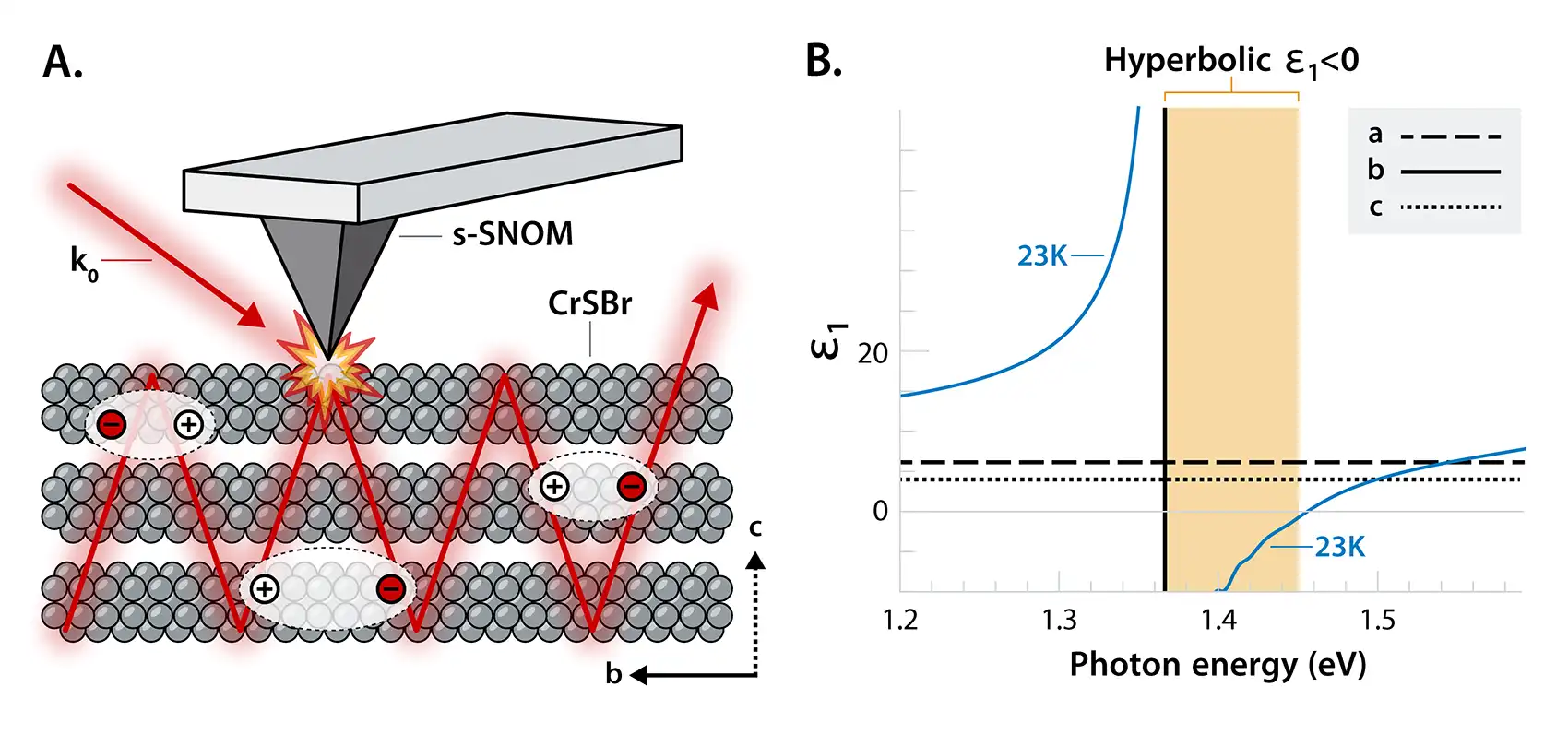Researchers Observe Evidence of Hyperbolic Exciton Polaritons
Promising New Pathways for Manipulating Excitons and Light Can Benefit Optoelectronics

The ability to move electron-hole pairs—called excitons—in desired directions is important for generating electricity and creating fuels. This happens naturally in photosynthesis, making it a source of inspiration to researchers innovating optoelectronic devices.
Strong coupling between light and excitons generates bosonic quasiparticles called polaritons that express unique properties that positively affect device performance.
Researchers observed steady-state hyperbolic exciton polaritons (HEPs)—exotic kinds of exciton polaritons with attractive properties—in the van der Waals magnet, chromium sulfide bromide (CrSBr).
They detailed their observations in “Hyperbolic exciton polaritons in a van der Waals magnet,” published in Nature Communications. NREL researchers devised the theoretical framework to explain the experiments performed at Columbia University. Researchers at King’s College London, the University of Washington, the Flatiron Institute, and Radboud University were also involved in the collaboration.
NREL’s Mark van Schilfgaarde, chief theorist and coauthor on this study, said, “Polaritons can arise when coupling between confined light and matter becomes strong. Usually, light-matter interaction is weak, and the light merely acts to perturb the material and change its quantum state. When it is strong, the light and matter can become entangled and form a new state containing both. These states—polaritons—have long been established, but what is new in this study is the observations of polaritons in a hyperbolic system. Exotic new modes called hyperbolic exciton polaritons (HEPs) have been predicted, and this study presents an experimental realization of them.”
Innovation and optimization of optoelectronic and photovoltaic devices such as light emitting diodes, solar cells, X-ray detectors, and other sensors are of interest to researchers and developers working toward better energy efficiency. Better performance of devices where conversion between matter and light is at the heart of their operation uses the available energy more efficiently and leads to higher sensitivities.
“Our study shows promising new pathways to manipulate excitons and light, which can improve optoelectronic device operation, including routes to magnetic, nonlocal, and quantum polaritonics,” van Schilfgaarde said.
Enabling Hyperbolic Exciton Polariton Imaging
Researchers exploited the unique geometry of semiconductors to finally image HEPs, which have been technically elusive. Microcavities—reflective mirrors that ensure coupling—in semiconductors are effective at trapping and stabilizing light to achieve exciton polaritons. Slabs of van der Waals semiconductors allow excitons in the semiconductor to strongly interact with light. Such geometry lends itself to nano-optical techniques and/or nanoscale imaging.
To achieve this strong coupling, cryogenic temperatures are needed in most van der Waals materials. Researchers developed a cryogenic near-infrared, near-field microscope to enable HEP imaging in the van der Waals semiconductor, CrSBr. This van der Waals material is unique because excitons exhibit both strong oscillator strength, which is the mechanism that enables electrons to be absorbed and emitted, and small scattering rates, which limit the lifetime.
“This was the first time a cryogenic near-infrared, near-field microscope was used in a published study,” said Frank Ruta, a Ph.D. student at Columbia University and coauthor on the paper. “We used near-infrared light in these experiments, which has a shorter wavelength than midinfrared light—making alignment of optics more challenging. Alignment at low temperature in an ultrahigh vacuum presents even more difficulties. These experimental conditions are necessary to observe HEPs, however, as CrSBr only becomes hyperbolic at low temperature and in the near infrared.”
Van Schilfgaarde and NREL computational science researcher Swagata Acharya built a robust, parameter-free theoretical framework for magnets both in their ordered and disordered variants—an approach that represents a step change in exploring the role of the order-disorder transition in magnetic excitons. This model can describe the excitons of a magnet both above and below a critical temperature called the Néel temperature. This is important because when the spins disorder above the Néel temperature, the excitons become darker—and many of the fundamental properties of HEPs depend on how bright these excitons are.
“We established a physical picture showing that the exciton’s brightness is influenced by the Néel temperature,” Acharya said. “This principle should be valid for a large class of van der Waals magnets and is not confined to CrSBr only.”
Observing Hyperbolic Exciton Polaritons at the Nanoscale
The team verified, through their cryogenic, near-infrared, near-field microscope, that strong coupling between excitons and polaritons occurs directionally in CrSBr at room temperature. The researchers proposed that this magneto-electronic coupling is partly responsible for the hyperbolicity in CrSBr (although this hyperbolicity only occurs at low temperature).
In the imaging experiment, the research team varied the temperature, microcrystal thickness, and energy dependence of subdiffractional fringes (where waves spread around and away from obstacles) to uncover the properties of HEPs.
“HEPs can confine light in semiconductors to spatial dimensions below conventional diffraction limits, allowing us to miniaturize optoelectronic excitonic devices beyond the limits that light normally imposes on us,” Ruta said. “However, HEPs observed in CrSBr are still far too lossy to be practical. The challenge for researchers now is to figure out how to extend HEP lifetimes. Incorporating CrSBr into a resonant cavity is a promising route, or we may search for materials with even stronger exciton resonances.”
“This manuscript also characterized, for the first time, how spin disorder modifies excitons, without recourse to model assumptions,” van Schilfgaarde said. “Having results grounded in a rigorous theory made it possible to interpret the experiment in terms of a simple picture, where magnetic order delocalizes the excitons and helps push CrSBr into the hyperbolic transition.”
Learn more about Basic Energy Sciences at NREL and about the U.S. Department of Energy Office of Science Basic Energy Sciences Program. Read “Hyperbolic Exciton Polaritons in a van der Waals Magnet” in Nature Communications.
Last Updated May 28, 2025
